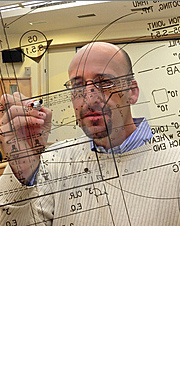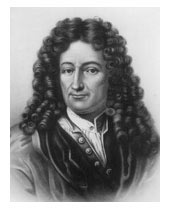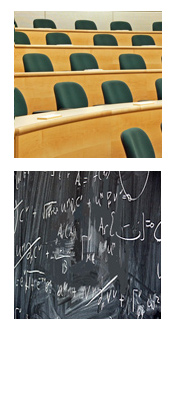LEIBNIZ UNIVERSITY porta il nome del grande filosofo e scienziato, vediamo di riportare una sua breve biografia.
Dotato di notevole intelligenza, Leibniz a soli sei anni aveva già imparato il latino leggendo Tito Livio e a quindici entrò all'Università di Lipsia. Conseguì una laurea in filosofia a diciassette anni ed un dottorato in legge a venti.
Leibniz, portando avanti la realizzazione di Pascal, costruì la prima calcolatrice meccanica capace di eseguire moltiplicazioni e divisioni. Sviluppò inoltre la forma moderna del sistema di numerazione binaria utilizzato oggi nell'informatica per i computer.
Molti studiosi si sono chiesti a cosa si sarebbe potuti giungere se Leibniz fosse riuscito a combinare le sue scoperte di aritmetica binaria con le sue realizzazioni nel calcolo meccanico.
Anche se esistono alcune discussioni sulla paternità originale, Leibniz è accreditato assieme ad Isaac Newton dell'invenzione, intorno al 1670, del calcolo infinitesimale: in base ai suoi appunti, un importante punto di svolta nel suo lavoro lo si ebbe il 17 aprile 1675, quando utilizzò per la prima volta il calcolo integrale per trovare l'area dell'insieme di punti delimitato dalla funzione y=x.
Egli introdusse diverse notazioni usate nel calcolo fino ai giorni nostri, ad esempio il segno dell'integrale ∫ che rappresenta una S allungata (dal latino summa) e la d usata per le derivate (dal latino differentia).
Leibniz pensava che i simboli fossero molto importanti per la comprensione delle cose. Egli cercò di sviluppare un "alfabeto del pensiero umano", nel quale cercò di rappresentare tutti i concetti fondamentali usando simboli, e combinando questi simboli per rappresentare pensieri più complessi, senza però mai giungere ad una conclusione di questo ambizioso programma.
Il suo contributo filosofico alla metafisica è basato sulla Monadologia, che introduce le Monadi come "forme sostanziali dell'essere". Le Monadi sono delle specie di atomi spirituali, eterne, non scomponibili, individuali, seguono delle leggi proprie, non interagiscono, ma ognuna di esse riflette l'intero universo in un'armonia prestabilita. Dio e l'uomo sono anche monade: le monadi differiscono tra loro per la diversa quantità di coscienza che ogni monade ha di sé e di Dio al suo interno.
Nel modo abbozzato in precedenza, il concetto di monade risolve il problema dell'interazione tra mente e materia che sorge nel sistema di Cartesio, così come l'individuazione all'apparenza problematica nel sistema di Baruch Spinoza, che rappresenta le creature individuali come semplici modificazioni accidentali di un'unica sostanza. La Theodicee tenta di giustificare le imperfezioni apparenti del mondo sostenendo che esso è il migliore tra i mondi possibili.
Il mondo deve essere il migliore e più equilibrato dei mondi, perché è stato creato da un Dio perfetto. In questo modo, è risolto a priori il problema del male; non a posteriori con un premio ultraterreno per i giusti, che Kant userà per argomentare l'immortalità dell'anima. Le idee non sono incompatibili; l'affermazione "è il migliore dei mondi possibili" è un tipico giudizio sintetico a priori.
Mentre la "soluzione a posteriori" è una verità di fatto, una ragion pratica (direbbe Kant); la soluzione "a priori" è una verità di ragione, una ragion pura (direbbe Kant) cui è tenuto il filosofo. La critica di Voltaire rimane filosofica perché mossa non su un piano metafisico, ma sul lato pratico delle esperienze umane, l'unico in cui è debole (come notava lo stesso Leibniz). Leibniz in nome della metafisica sosteneva la prima verità.
Leibniz ha inventato la matematica dei limiti ed il principio degli indiscernibili, utilizzato nelle scienze, secondo il quale due cose che appaiono uguali - e fra le quali quindi la ragione non trova differenze - sono uguali. Da questo principio deduce il principio di ragion sufficiente per il quale ogni cosa che è, ha una causa. Questo principio implica il primo, nel senso che per parlare di differenza deve esserci un motivo (vedere delle differenze, appunto), rendendo inutile operare "distinguo" a tutti i costi.
Il principio di ragion sufficiente lo obbligava davanti ai mali del mondo a trovarvi una giustificazione, senza negarne l'esistenza a differenza della posizione di Sant'Agostino d'Ippona e di altri filosofi.
La frase "Viviamo nel migliore dei mondi possibili" fu guardata con divertimento dai suoi contemporanei, soprattutto François Marie Arouet de Voltaire, che parodiò Leibniz nella sua novella Candide, dove Leibniz appare come un certo Dottor Pangloss. Questo nome deriva dalla ricerca quasi disperata (e mai conclusa, ovviamente) di Leibniz di creare un linguaggio universale, basato su degli elementi minimi comuni a tutte le lingue. Da quest'opera il termine panglossismo si riferisce a persone che sostengono di vivere nel miglior mondo possibile.
La concezione di Leibniz era contrapposta alla tesi di Newton di un universo costituito da un moto casuale di particelle che interagiscono secondo la sola legge di gravità. Tale legge, infatti, secondo Leibniz era insufficiente a spiegare l'ordine, la presenza di strutture organizzate e della vita nell'universo e più razionale del continuo intervento dell'"Orologiaio" creatore dell'universo ipotizzato da Newton.
Leibniz è ritenuto la prima persona ad aver suggerito che il concetto di retroazione fosse utile per spiegare molti fenomeni in diversi campi di studio.
LEIBNIZ UNIVERSITY BOOKSTORE
 bibliotecario e avvocato tedesco, di probabile origine slava, ma di sicura, recente, ascendenza sassone.
bibliotecario e avvocato tedesco, di probabile origine slava, ma di sicura, recente, ascendenza sassone.


 Trustees sought to find a name that would exemplify an international and interdisciplinary approach to education and learning. We arrived at the name of Leibniz from the seventeenth century mathematician, philosopher and political advisor Gottfried Wilhelm Leibniz.
Trustees sought to find a name that would exemplify an international and interdisciplinary approach to education and learning. We arrived at the name of Leibniz from the seventeenth century mathematician, philosopher and political advisor Gottfried Wilhelm Leibniz. Leibniz was a member of the Royal Academy of Science in London and the Academy of Sciences in Paris. He and Newton were elected as the first foreign members of the prestigious Parisian Academy of Sciences. In 1700, Leibniz induced King Frederick I of Prussia to found the Academy of Sciences in Berlin and Leibniz became the founding president.
Leibniz was a member of the Royal Academy of Science in London and the Academy of Sciences in Paris. He and Newton were elected as the first foreign members of the prestigious Parisian Academy of Sciences. In 1700, Leibniz induced King Frederick I of Prussia to found the Academy of Sciences in Berlin and Leibniz became the founding president.
